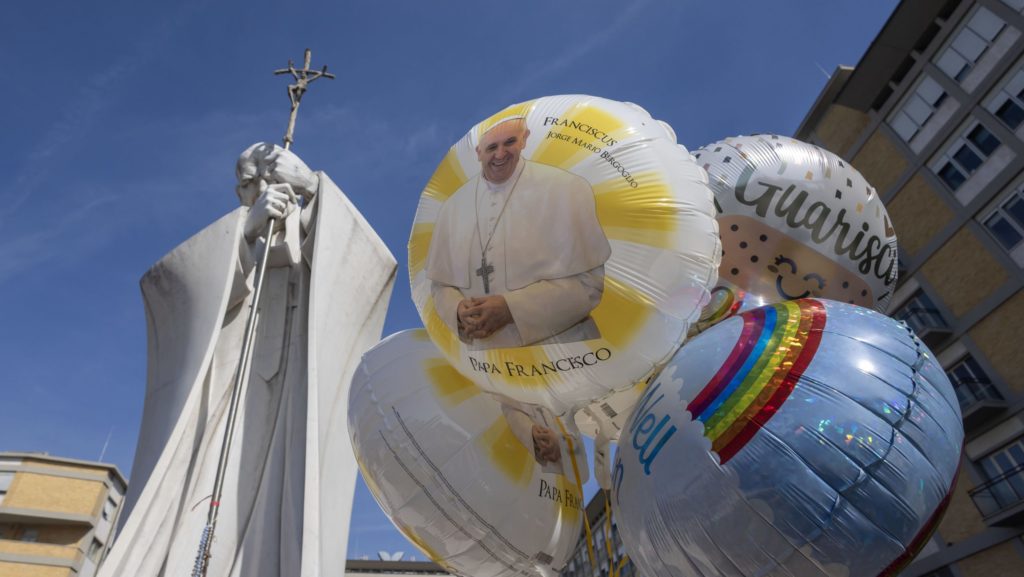While Italy's main news agency reported that Pope Francis' respiratory "crisis" had subsided, a Vatican source said he was still receiving supplemental oxygen by nasal cannula early Feb. 23.
The evening before, the 88-year-old pope's doctors said that he had experienced "an asthmatic respiratory crisis of prolonged magnitude, which also required the use of oxygen at high flows."
The doctors, in a bulletin released by the Vatican Feb. 22, also said the pope had required a blood transfusion because of a low platelet count and described his condition as "critical," adding that "at the moment the prognosis is reserved."
Since the pope checked into Rome's Gemelli hospital Feb. 14 with bronchitis and difficulty breathing, the Vatican press office has issued a short morning bulletin, which mainly described how he slept and if he was able to get out of bed to eat breakfast.
The Feb. 23 morning statement said only, "The night passed quietly; the pope rested."
The Vatican also released a message written by the pope for the midday recitation of the Angelus prayer, but did not say what day the pope wrote it.
"I am confidently continuing my hospitalization," the pope wrote, "carrying on with the necessary treatment; and rest is also part of the therapy!"
Pope Francis publicly thanked the doctors and health care workers "for the attention they are showing me and the dedication with which they carry out their service among people who are sick."
The pope also thanked people for the "many messages of affection" that he has received, particularly the letters and drawings sent by children.
"Thank you for this closeness and for the prayers of comfort I have received from all over the world," he wrote.
Many of those prayers have been coming from the faithful who gather in the large courtyard beneath his suite of rooms at the hospital. The immense stone statue of St. John Paul II is the focal point where visitors gravitate to pray and leave flowers, candles, rosaries, cards, drawings and notes. A sun-worn pot of plastic poinsettias was brightened by newer offerings of magenta orchids, white cyclamens and red roses.
One man, who came from Naples Feb. 23, was sporting a black jacket bursting with a colorful homage to Diego Armando Maradona, "el Dios del fútbol" (the god of soccer). He set five helium balloons tied to a weight by the statue, one with a glittering rainbow and the words, "Get well soon."
Sister Geneviève Jeanningros, a member of the Little Sisters of Jesus who sits in the front row most Wednesdays at Pope Francis' weekly general audience, was also among the few who were praying in the courtyard late that morning.
While there have been more journalists in the courtyard than faithful most days since the pope was admitted Feb. 14, that changed about 10 minutes before noon Feb. 23. More than 60 young people and members of a community connected with the Pontifical Academy of the Immaculate Conception arrived to pray the midday Angelus. They were joined later by Cardinal Angelo De Donatis, the head of the Apostolic Penitentiary and the pope's former vicar for the Diocese of Rome from 2017 to 2024.
Father Giacomo Martinelli, who heads the academy's pastoral initiatives and was leading the group, told reporters the pope needs everyone's prayers "like Jesus in Gethsemane."
The young people feel especially close to the pope, he said, as many of them go to St. Peter's Square every Sunday where they and members of the House of Mary community, which he founded, hold the banner "The Immaculate Conception will triumph." The community has been bringing the banner to every Sunday Angelus since the feast of the Immaculate Conception Dec. 8, 1994.
"It is a time of trial for everyone," Father Martinelli said. But the pope knows and teaches that "the first thing to do is to abandon oneself to God."
"Prayer works. It is God's power," the priest said.
Cardinal De Donatis told reporters that this was a time "to intensify one's prayers" and to ask God to give the pope strength. "We're here to help him feel our closeness" and "this strong embrace."
A few dozen other people made their way to the courtyard and joined a Franciscan friar who led the singing of the Angelus and the recitation of the rosary with three nuns.
A mother and her daughter, both wearing heart-shaped sunglasses, knelt before the statue and set down four red and silver heart-shaped mylar balloons tied to a pot of flowers.
"Francis is the pope of the frail and the weak," said the mother, Violetta. Now that he has become weak, too, "being here seemed the right thing."
She said she feels a special bond with Pope Francis because her daughter, Maria, was born around the same time the pope was elected in March 2013.
Many people had told Violetta that Maria would never be able to do many things because of her autism. "But she drew this!" the mother said, beaming, holding a drawing of the pope surrounded by people and the words, "Be strong Francis. We are with you." They hoped to somehow get the drawing to the pope.
"I deeply believe love and giving oneself over to God's love" conquers all, said Violetta, who came to Rome from Poland in 2009.
She said she was deeply attached to her fellow Pole, St. John Paul, but each pope has a different mission specific to each time. Pope Francis "came at the right moment" to bring and remind people of the need for "simplicity and tenderness."

